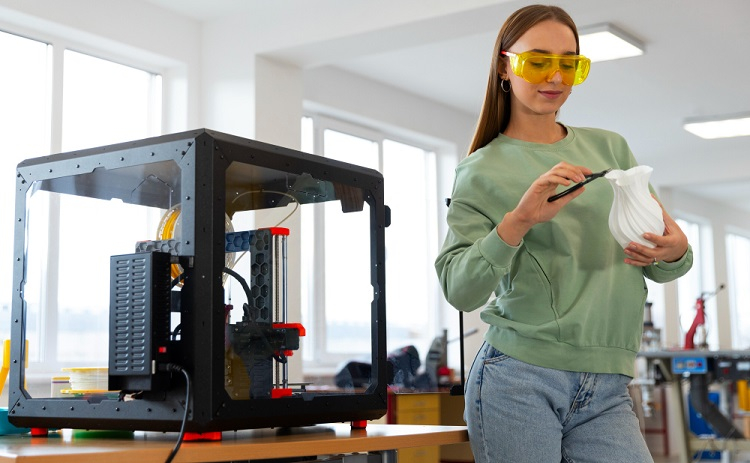Discover the state-of-the-art in 3D printing machine technology and its impact on the future of manufacturing. Efficacy, Rapidity, and Cutting-Edge Technology at Your Disposal.
As we have already mentioned, there are two common factors that 3D printing applications share. Our guidance is typically 1–50 parts if your part quantities are low.
It’s worth looking into other manufacturing methods as volumes rise to the hundreds. 3D printing may be the only way to go if your design has a complex geometry, such as an aluminum part with an internal cooling channel.
The key to selecting the right technology for your application is to balance the benefits and limitations of each technology.
9 Types of 3D Printing Machine Technology
At the beginning stages of ideas, when you only need a model to show a colleague, stair-stepping surfaces on your part won’t be of concern.

Once you reach the point where you have to test users, cosmetics and durability become essential.
While there are addup solutions, correctly utilizing 3D printing technology during product development will reduce design risks and ultimately result in better products.
#1. Polymer 3D Printing
Let’s look at some standard 3D printing methods for plastic and discuss when they are most helpful to designers, engineers, product developers, and other stakeholders.
#2. Stereolithography (SLA)
Stereolithography (SLA), the first industrial 3D printing method, is best known. SLA printers can produce fine details, smooth surfaces, and tight tolerances.
SLA parts have high-quality surface finishes that look great and aid in function. For example, who can use them to test the fit of an assembled position?
It is widely used in the medical industry. Typical applications include microfluidics and anatomical models. Manufacturers develop Formup 3D printers for manufacturers.
#3. Selective Laser Sintering
Selective laser sintering is a process that melts nylon-based powders to form solid plastic. Parts made from SLS are made of accurate thermoplastic material and are suitable for functional testing.
They can also support snap-fits and living hinges. Pieces made from SLS are stronger than SL but have rougher surfaces.
SLS does not require support structures, so you can use the entire build platform for nesting multiple parts in a single build.
This makes it more suitable for larger part quantities than other 3D printing processes. Many claims made about SLS are used to create prototypes that can be molded in the future. We use 3D-Systems sPro140 machines for our SLS printers.
#4. PolyJet
PolyJet is another 3D plastic printing process. But there’s an extra twist. It can produce parts with multiple properties, such as colors or materials.
Designers can use the technology to prototype elastomeric and overmolded parts. We recommend using SL or SLS if your design is a single, rigid material. It’s cheaper.
PolyJet is an excellent tool for prototyping silicone rubber or overmolding designs. You can validate and iterate your design more quickly and cost-effectively.
#5. Digital Light Processing (DLP)
SLA and digital light processing are similar because they cure the liquid resin with light. DLP uses a projector screen, while SLA uses a laser.
This is the main difference. DLP 3D printers can image a complete build layer at once, resulting in faster build speeds.
DLP printing is often used for rapid prototyping, but it can also produce low-volume plastic parts.
#6. Multi-Jet Fusion (MJF)
Multi-Jet Fusion is similar to SLS because it uses nylon powder to create functional parts. MJF uses an array of inkjets to apply fusion agents to the nylon powder bed.
A heating element is used to heat the bed to fuse the layers. The MJF process results in a better surface finish and more consistent mechanical properties than SLS.
The MJF process has another advantage: it takes less time to build, which results in lower production costs.
#7. Fused Deposition Modeling
Fused deposition modeling (FDM), a desktop 3D printer technology for making plastic parts, is standard.
FDM printers work by extruding plastic filament layer-by-layer onto a build platform. This is a fast and cost-effective way to produce physical models.
FDM can be used in functional testing, but it is not recommended due to parts with rough surfaces and low strength.
#8. Direct Metal Laser Sintering
Metal 3D printing opens new doors for metal part design. Protolabs uses direct metal laser scanning (DMLS) to 3D-print metal parts.
This reduces multi-part metal assemblies into one component or lighter factors with hollowed-out or internal channels.
DMLS can be used for prototyping and production, as details are denser than those made with traditional metal manufacturing techniques like casting or machining.
DMLS can create metal components with complex geometries, making it ideal for medical applications.
#9. Electron Beam Melting (EBM)
Another 3D printing technology for metal is electron beam melting. This uses electromagnetic coils to control an electron beam that dissolves the metal powder.
During the build, the printing bed is heated up in a vacuum. The material being used determines the temperature at which the material will be heated.









